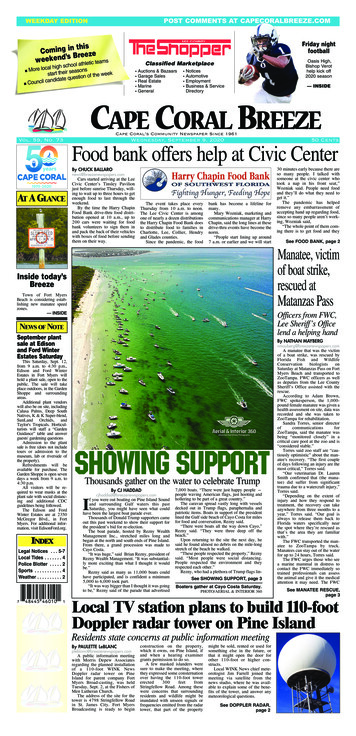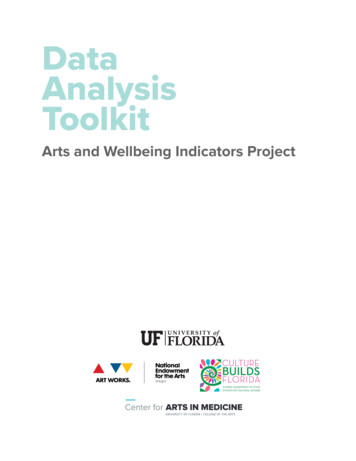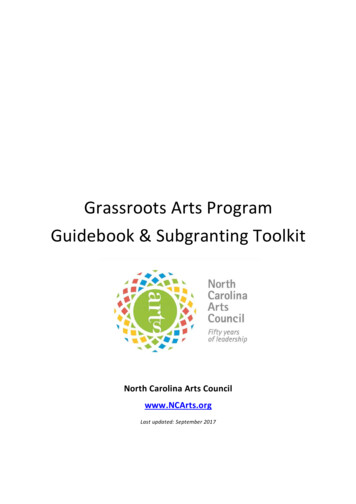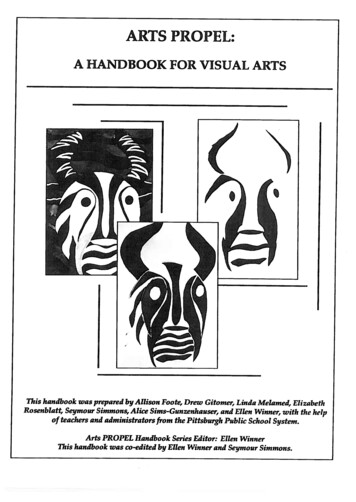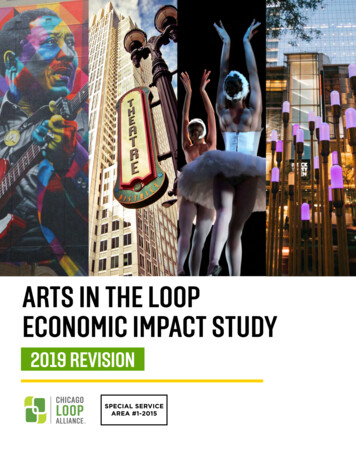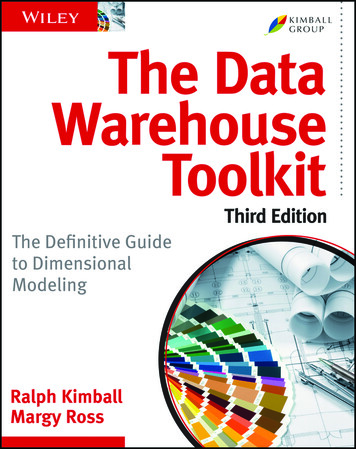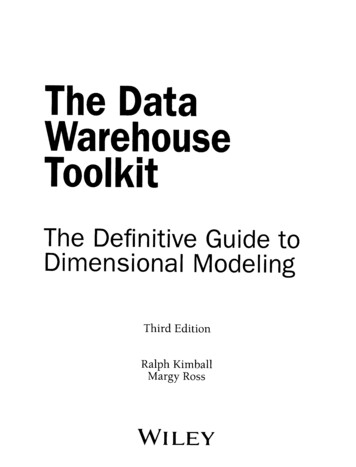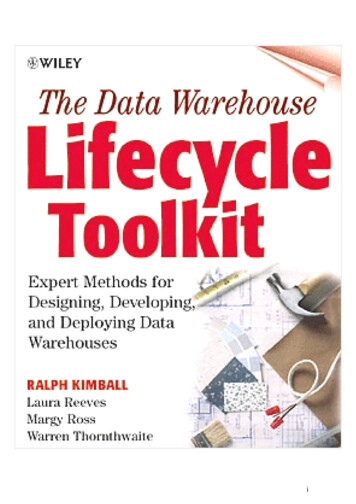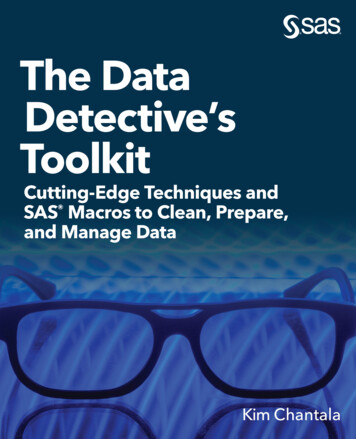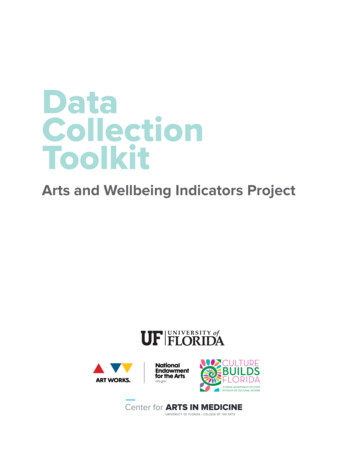
Transcription
DataCollectionToolkitArts and Wellbeing Indicators Project
Table of ContentsIntroduction to the Arts and Wellbeing Indicators Project . . . . . . . . . . . . .3The Arts and Wellbeing Indicators Model . . . . . . . . . . . . . . . . . . . . . . . . . . . . .4The Toolkit: Introduction and Process Overview . . . . . . . . . . . . . . . . . . . . . .5Preparation for Implementing the Survey . . . . . . . . . . . . . . . . . . . . . . . . . . . .6Creating a Core Team . . . . . . . . . . . . . . . . . . . . . . . . . . . . . . . . . . . . . . . . . . . . .6Partners . . . . . . . . . . . . . . . . . . . . . . . . . . . . . . . . . . . . . . . . . . . . . . . . . . . . . . . . . . . 6Defining your Community and Sample Size . . . . . . . . . . . . . . . . . . . . . . . .6Costs . . . . . . . . . . . . . . . . . . . . . . . . . . . . . . . . . . . . . . . . . . . . . . . . . . . . . . . . . . . . .7Data Management and Survey Platforms . . . . . . . . . . . . . . . . . . . . . . . . . . .9Ethics and Institutional Review Board (IRB) Review . . . . . . . . . . . . . . . . . .9Surveying . . . . . . . . . . . . . . . . . . . . . . . . . . . . . . . . . . . . . . . . . . . . . . . . . . . . . . . . . . . 10Setting Up the Survey . . . . . . . . . . . . . . . . . . . . . . . . . . . . . . . . . . . . . . . . . . . . . 10Qualtrics . . . . . . . . . . . . . . . . . . . . . . . . . . . . . . . . . . . . . . . . . . . . . . . . . . . . . . . . . . . 10SurveyMonkey . . . . . . . . . . . . . . . . . . . . . . . . . . . . . . . . . . . . . . . . . . . . . . . . . . . . . 13Using Social Media for Surveying . . . . . . . . . . . . . . . . . . . . . . . . . . . . . . . . . . . 13Training the Staff and Surveyors . . . . . . . . . . . . . . . . . . . . . . . . . . . . . . . . . . . . 14Collecting and Inputting the Data . . . . . . . . . . . . . . . . . . . . . . . . . . . . . . . . . . 18Preparation for Data Analysis . . . . . . . . . . . . . . . . . . . . . . . . . . . . . . . . . . . . . . . . 20Files . . . . . . . . . . . . . . . . . . . . . . . . . . . . . . . . . . . . . . . . . . . . . . . . . . . . . . . . . . . . . . . . . 21
Introduction to the Arts and Wellbeing Indicators ProjectThe State of Florida Division of Cultural Affairs has partnered with the University of Florida Center forArts in Medicine on a three-phase project to develop a set of indicators for associating the arts withwellbeing at the community level. The Arts and Wellbeing Indicators project supports the Division’sstrategic goal of promoting healthy, vibrant, and thriving communities in Florida.The mission of the State of Florida Division of Cultural Affairs (DCA), as stated in its strategic plan for2015-2020, is to “Advance, support, and promote arts and culture to strengthen the economy andquality of life for all Floridians.” Further, the plan asserts a goal to “promote healthy, vibrant, thrivingcommunities”. The Arts and Wellbeing Indicators project is a step toward strengthening that mission,and a step toward documenting that Florida’s investments in the arts have positive health impacts onFlorida’s communities. This work aligns with the DCA’s commitment to advancing arts and culture inthe State of Florida and makes it possible to provide important data to arts advocates and arts organizations in keeping with its strategic goal to “collect, distill, and disseminate current information thatadvances arts and culture in Florida.”The Arts and Wellbeing Indicators model is a tool for assessing the associations between arts participation and wellbeing in communities. It is important to note that association is distinct from correlation or causation, and that the Indicators model does not identify a direct cause and effect relationship between arts participation and wellbeing. However, the project has found that the 13 indicatorsand the survey tool are effective in assessing associations between the arts and wellbeing. The modelincludes the primary domains of wellness, arts, and community. Wellness encompasses health andquality of life; the arts domain encompasses participation, access, value, infrastructure, and investment; and the domain of community encompasses civic involvement, satisfaction with leadership,openness, safety, social capital, and satisfaction with community.A single 24-question survey, which takes an average of ten minutes to complete, was developed toassess each of the model’s variables. Over the project’s second and third phases, the survey was tested in nine Florida counties. An array of surveying methods, including paper and pencil, telephone,and electronic methods were tested and also assessed for cost-effectiveness. The project also testedthe reliability of survey outcomes and the feasibility of the instrument for assessing these outcomes.Additionally, overall findings confirmed positive associations between arts participation and wellbeing at the community and state levels.This toolkit is designed to guide the use and administration of the Arts and Wellbeing Indicatorssurvey. An additional toolkit is available to guide data analysis. This toolkit will provide guidance fordeveloping a core team and partners, determining the right sample size for the community, budgeting for the project, setting up and administering the survey, and managing the survey data. Guidanceis also provided for using various survey platforms and for using social media to distribute the survey.3
The Arts and Wellbeing Indicators Model4
The Toolkit: Introduction and Process OverviewThe Arts and Wellbeing Indicator Toolkit is a resource designed to guide an organization in the use ofthe Arts and Wellbeing Indicator survey. The diagram overviews the general process of using implementing the survey1234567
Preparation for Implementing the SurveyCreating a Core TeamThe Arts and Wellbeing Indicators survey was developed and tested by aresearch team at the University of Florida. The team was comprised of researchers from the arts, public health and epidemiology, along with a team ofinterdisciplinary research assistants. Although research or evaluation experience is helpful, a team with research experience is not necessary for usingthe Arts and Wellbeing Indicators and achieving high-level results. This toolkitwas created for use by organizations and individuals with varying degrees ofresearch and evaluation experience.In general, the primary functions or roles required for utilizing the Arts and WellbeingIndicators are: Overall project guidance –typically carried out by a principal investigatoror a project director/manager/coordinator Surveying in the field – typically carried out by research assistants, program staff orvolunteers, with oversight by the principal investigator or project director Data management – typically carried out by a coordinator Data analysis – carried out by a statistician, ideallyIn some cases, surveying may be accomplished entirely by electronic means, eliminating the need forstaff or volunteers to survey in the field. The team should determine the best methods for achievingparticipation in the survey that ensures the broadest level of demographic participation possible.PartnersMost communities have organizations interested in public health and well-being, who might beinterested in contributing to your surveying project. It is important that organizations carrying outthe surveying and analysis consider such partnerships, especially in their efforts to collect unbiasedand representative data. Fostering partnerships with different and diverse organizations will bolsterthe quality of a data set by ensuring a more representative demographic sample. It is recommendedthat, once the toolkit and all its materials are understood, your organization look for these potentialpartnerships. Specifically, partnerships within and outside of the arts are critical to achieving a diverse and representative sample.6
Defining your Community and Sample SizeThis toolkit and statistical model have been tested at the county, region andstate levels. The model can be used at any community scale, up to the statelevel.The model requires a certain sample size relative to the respective countypopulation size. In the testing phases, rural communities proved to be morechallenging to engage, and it was determined that local partnership is key tosuccess in smaller communities.Geographical boundaries should be established as a starting point. Since the survey uses zip codesto determine a participant’s residence, it is recommended that geographic boundaries align with zipcodes. These boundaries may be defined by the scope of the organization or the population that isserves.After you establish your target geographic location, you can calculate your sample size and determine your demographic targets. There are many ways to calculate sample size. Refer to a statisticianif you have one on your team. Otherwise, refer to this sample size calculator, keeping the default 95%confidence interval and 5% margin of calculator/Be sure to set clear targets for participation that align with the demographics of the geographicregion. For example, if your target geographic region has a population of 45% Caucasian, 25% AfricanAmerican and 30% Latinx community members, you should seek and track this same balance amongsurvey participants. You may need to adjust your surveying methods as you collect data in order toachieve a representative population.CostsCosts for utilizing the Arts and Wellbeing Indicators will vary and can be guided by the availability ofresources, including human and fiscal resources. As previously noted, an array of methods for surveyadministration have been tested. General cost effectiveness of each of the methods has been determined, as follows.Electronic surveying methods, including making iPads available for surveying at monitored publiclocations, and e-mail survey distribution, were found to be most cost effective. Distribution of thesurvey via social media may be effective, but can be costly depending on the size and diversity of theorganization’s local social media network. Boosting and geographically targeting ads can be costly.7
Testing in counties ranging from rural to urban suggested that surveying in the field by volunteersusing iPads was the most successful in regard to participation and was also the most cost-effectivemethod. In one urban community, surveys were administered in the field by paid research assistantsand volunteers using iPads and paper and pencil surveys (providing participant choice). A total of382 surveys were collected at a total cost of 3,740. This cost represents 198 hours of surveying andproject management time. In a suburban community, 264 surveys were collected in the field usingthe same methods for a cost of 2,814 over 64 effort hours, and an additional 100 surveys were completed using a random-digit telephone survey service for a cost of 5,000 over a four-week period oftime. The cost for phone surveying will drop incrementally per 100 surveys after the first 100. Whiletelephone surveying is the most expensive method, it was found to be the most effective method forgarnering a true representative demographic sample. Paper and pencil surveys were found to be themost effective means for data collection in rural counties. E-mail surveying was shown to be effective in urban, suburban and rural communities, especially when the organization administering thesurvey had or was linked to large social media networks. In one testing community, 80 surveys werecollected over a 20-day span for a total cost of 180.The most significant cost involved in the surveying process may be the time needed to clean (prepare for analysis), and analyze the data. With an average sample of 350-400, approximately 35-60hours may be needed for data cleaning, analysis and reporting.It is advised that a budget of 3,000 - 10,000 be allocated for utilization of the Arts and WellbeingIndicators, including data collection and analysis. A smaller budget can be very effective and wouldrely on partnership between two or more organizations and on volunteers to administer surveys andprepare the data for analysis. This budget would also support the time needed for a statistician toconduct the analysis. A 10,000 budget would allow for costlier forms of data collection, such as telephone surveying and paid social media advertising, as well as involvement of paid research assistantsand other staff.8
Data Management and Survey PlatformsThe Arts and Wellbeing Indicators survey can be effectively administered using Qualtrics or SurveyMonkey. Qualtrics is considerably more expensive ( 3,000- 5,000), but if you are affiliated with a larger organization, you may already have access. SurveyMonkey costs about 35 per month, dependingon your subscription package. Qualtrics was used exclusively in the testing and in the develop thistoolkit. However, instructions for both Qualtrics and SurveyMonkey setup are provided in this manual. Both of these systems will securely manage the survey data and provide some analysis and reporting features.Ethics and Institutional Review Board (IRB) ReviewThe Arts and Wellbeing Indicators survey does not include the collection ofinformation that could identify survey participants. However, in some cases, especially when academic institutions or health providers are involved,ethical or Institutional Review Board (IRB) approval may be needed for datacollection and analysis. Often, projects that involve surveys in a communityrequire these approvals. This guarantees that evaluation or research is beingdone in a safe and ethical manner. This oversight can help to ensure the privacy and safety of survey respondents and the protection of collected data.It is important to explore the potential need for research review or approval within a given community, organization, or institution. Every academic and healthcare institution is connected to an IRB. Additionally, health departments and school boards may have their own IRB or other research oversightentities. When this type of oversight is not necessary, the following general ethical guidelines shouldbe applied to data collection, management and sharing.9
SurveyingSetting Up the SurveyThe survey has two main formats: paper and electronic. Electronic surveysmay be administered via e-mail or using iPads in location-based data collection. Electronic surveys minimize the potential for participant data entry errors. A word document version of the survey titled “Paper Printable Survey”is available by contacting the Center for Arts in Medicine at cam@arts.ufl.edu.If you are using the paper and pencil survey format, you will need to use Qualtrics or SurveyMonkeyfor managing your data. In this case, you would manually input paper and pencil survey responsesinto the electronic survey format. If you are using both paper and electronic formats for data collection, you should set up separate Qualtrics or SurveyMonkey interfaces. This will allow you to distinguish results across data collection formats and also to create a record number for paper surveys.Use of both Qualtrics and SurveyMonkey surveying/data management platforms are outlined below.QualtricsQualtrics is an online surveying platform, and has been found to be highly effective for administration of the Arts and Wellbeing Indicators survey. If you are using Qualtrics for surveying, you mayrequest Qualtrics survey templates from the UF Center for Arts in Medicine.To request templates, please e-mail cam@arts.ufl.edu.Setting up the survey in QualtricsYou can obtain the “Electronic Survey Template.qsf” and “Paper Survey Template.qsf” files bycontacting the Center for Arts in Medicine as indicated above. After obtaining and downloading thefiles to your computer, follow the “creating from a file” section in the following link to add both files toyour Qualtrics omAFile10
Your dashboard should look something like this after you’ve uploaded:In the first block of the electronic survey, insert a paragraph or two about your organization and anygoverning bodies that have approved surveying in your area. Also, include contact information forthe person responsible for the survey in your organization. Make sure to insert this language in theprintable word document version of the survey as well. This is the first thing the respondents will see.The block you should edit is in the screenshot below:11
Distributing the survey using QualtricsYou won’t need to make any other changes to the template other than the first screen. In the electronic version of the survey, click “Distributions” at the top of your screen, under the title of yoursurvey. There are many options for distributing the survey. Browse through which functionalities youthink will be the most efficient and useful. The Anonymous link will be sufficient if you have your ownemail list you want to use. The Distribution Summary will help you keep track of when and by whatmethod surveys are collected.The paper version of the survey on Qualtrics will be used later on for inputting paper surveys:12
Offline iPad Setup in QualtricsThe Qualtrics iPad app allows you to survey in the field without an internet connection. After downloading the application to your device, link the offline iPad app to the electronic survey on Qualtrics.Follow the “Setting up the offline app” instructions at the following rveyMonkey may be used in lieu of Qualtrics. It will require more setup time, since survey templates cannot be exported or imported. Please refer to the Qualtrics process overview to adapt SurveyMonkey to the data collection process.Setting up the surveyAfter signing up for a SurveyMonkey account and paying for a subscription, you will need to createa version of the survey in SurveyMonkey for distribution. To do this, obtain the “Electronic Survey(with coded values)” word document by contacting cam@arts.ufl.edu. Please make sure your SurveyMonkey survey reflects the questions exactly as they appear on the document. The survey’s answersare coded with specific numbers, which need to match your newly created survey in SurveyMonkey.Please refer to SurveyMonkey support pages to learn how to best distribute the survey to participants.Offline iPad SetupSurveyMonkey does not have support for Offline iPad surveying.Using Social Media for SurveyingSocial media is an increasingly effective means for surveying the public. Facebook ads can be used,as can Instagram and other social media formats. Facebook ads have been tested and found to havepotential, particularly when compelling images and captions are paired with the survey link. The‘anonymous link’ feature of Qualtrics may be used to embed the link in a Facebook post. Please notethat if you are administering the survey under IRB or other ethical approval, you may need to includespecific language in the post. Choosing a picture that draws people in is important. If you don’t haveyour own pictures to use, Facebook has some good stock photos.13
In addition, Facebook ads that hone in on geographic areas within a 25-mile radius may be moresuccessful than those that incorporate larger regions. And, it can be helpful to note that most peopletend to complete surveys through social media later at night. Review these Facebook ad policies tomake sure your ad follows their ining the Staff and SurveyorsAll of the individuals involved in the project should be trained in regard to thesurveying and data management processes. The following sections will providea framework for that training.Comfort and Privacy of ParticipantsC
The Arts and Wellbeing Indicators model is a tool for assessing the associations between arts partici-pation and wellbeing in communities. It is important to note that association is distinct from correla-tion or causation, and that the Indicators model


